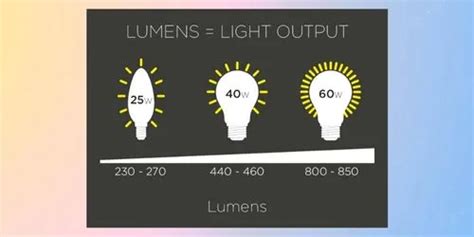Understanding Lumens
Lumens are the standard unit of measurement for the total amount of visible light emitted by a light source. One lumen is equal to the amount of light produced by a single candle that falls on one square foot of surface located one foot away from the candle. The higher the lumen rating, the brighter the light output.
It’s important to note that lumens differ from watts, which measure the amount of energy consumed by a light bulb. With the advent of energy-efficient LED and CFL bulbs, the relationship between watts and brightness has become less relevant. Instead, lumens provide a more accurate representation of a bulb’s brightness.
Factors Affecting Lumens Needed
Several factors influence the number of lumens required for a particular space or task. These include:
Room Size and Layout
The size and layout of a room play a significant role in determining the lumens needed. Larger rooms generally require more lumens to achieve adequate illumination. Additionally, the shape of the room and the presence of windows or reflective surfaces can impact the light distribution.
Ceiling Height
The height of the ceiling affects how far the light has to travel to reach the desired surface. Higher ceilings typically require higher lumen output to compensate for the increased distance the light has to cover.
Task Requirements
The specific task or activity being performed in a space also influences the lumens needed. Tasks that require greater visual acuity, such as reading or detailed work, demand higher lumen levels compared to general ambient lighting.
Personal Preferences
Individual preferences for light intensity can vary. Some people prefer brighter environments, while others find lower light levels more comfortable. Consider your personal preferences when determining the lumens needed for a space.
Recommended Lumens for Different Rooms
The following table provides general guidelines for the recommended lumens per square foot for various rooms and spaces:
| Room/Space | Lumens per Square Foot |
|---|---|
| Living Room | 10-20 |
| Bedroom | 10-20 |
| Kitchen | 30-40 |
| Bathroom | 70-80 |
| Home Office | 50-60 |
| Dining Room | 30-40 |
| Hallway/Stairway | 5-10 |
These recommendations serve as a starting point, and you can adjust the lumen output based on your specific needs and preferences.

Lumens for Specific Lighting Applications
In addition to general room lighting, there are specific lighting applications that require different lumen outputs. Here are some common examples:
Task Lighting
Task lighting focuses on providing targeted illumination for specific activities. The following table outlines the recommended lumens for various task lighting applications:
| Task | Lumens Needed |
|---|---|
| Reading | 400-800 |
| Writing | 500-1000 |
| Sewing | 800-1200 |
| Cooking | 500-1000 |
| Makeup Application | 800-1200 |
Accent Lighting
Accent lighting is used to highlight specific features or objects in a room, such as artwork or architectural elements. The lumens needed for accent lighting depend on the size and reflectivity of the object being illuminated. As a general rule, aim for three times the ambient light level for effective accent lighting.
Outdoor Lighting
Outdoor lighting serves various purposes, including safety, security, and aesthetics. The lumens needed for outdoor lighting vary based on the specific application:
| Outdoor Area | Lumens Needed |
|---|---|
| Pathway | 100-200 |
| Porch | 200-400 |
| Floodlight | 700-1300 |
| Landscape Light | 50-300 |
Frequently Asked Questions (FAQ)
-
What is the difference between lumens and watts?
Lumens measure the total amount of visible light emitted by a bulb, while watts measure the amount of energy consumed. With energy-efficient bulbs, watts no longer accurately represent brightness. -
Can I replace a 60-watt incandescent bulb with a 1000 lumen LED bulb?
Yes, a 1000 lumen LED bulb is roughly equivalent to a 60-watt incandescent bulb in terms of brightness. However, the LED bulb will consume significantly less energy. -
How many lumens do I need for a small bedroom?
For a small bedroom (around 100 square feet), aim for 1000-2000 lumens in total. This can be achieved through a combination of ambient and task lighting. -
What is the best color temperature for a home office?
For a home office, a color temperature between 3500K and 5000K is recommended. This range provides a cool white to daylight color, which promotes alertness and concentration. -
Do I need special bulbs for dimmer switches?
Yes, if you plan to use a dimmer switch, make sure to choose bulbs that are compatible with dimming. LED bulbs designed for dimming will have this information clearly stated on the packaging.
Conclusion
Understanding lumens is crucial when selecting light bulbs for your home or workspace. By considering factors such as room size, ceiling height, task requirements, and personal preferences, you can determine the optimal number of lumens needed for each space. Use the guidelines and recommendations provided in this article as a starting point, and don’t hesitate to adjust the lumen output to suit your specific needs. With the right amount of lumens, you can create a well-lit and comfortable environment that enhances your daily activities and overall well-being.

No responses yet